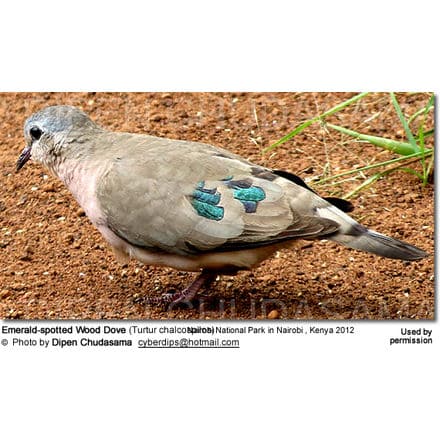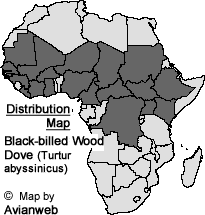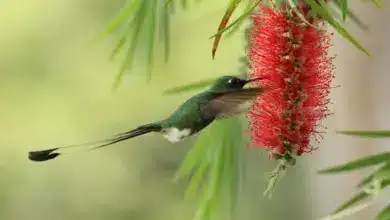Black-billed Wood Doves
The Black-billed Wood Doves (Turtur abyssinicus) – also known as Uganda or Sudan Black-billed Wood Doves, or Abyssinian Wood Doves – are widespread in a belt across Africa just south of the Sahara Desert.
They are also sometimes referred to as “Blue-spotted Wood Doves,” leading to confusion with the related and similar Blue-spotted Wood Doves ssp. Turtur afer.
They are closely related to the Emerald-spotted Wood Doves (Turtur abyssinicus) with whom they have formerly been considered conspecific (the same species). Their range overlaps in a limited area in Ethiopia, extreme south-east Susan – and on rare occasions in north-west Kenya and north-east Uganda.
Further Dove Information
- Dove Information
- Index of Dove Species
- Photos of the Different Dove Species for Identification
- Doves & Pigeons as Pets
Distribution / Habitat
The Black-billed Wood Doves occur in the drier parts of tropical Africa, north of the equator.
Specifically, they are found in South Mauritania, Senegal, Gambia, Togo, Benin, Nigeria, east through northern Cameroon, north central African Republic to Eritrea (at the very east end of Africa) south to Ethiopia, northern Uganda, and extreme northwestern Kenya.
They are resident (non-migratory) throughout their range and are commonly found near deserts, scrub, and savannah.
These pigeons are usually seen alone or in pairs but may form large flocks at waterholes or favored feeding areas.

Description
Black-billed Wood Doves are small plump pigeons that measure 7.5 – 8 inches (19 – 20 cm) in length and weigh about 2.3 oz (65 grams). Their bills are black, as suggested by the common name.
The back, wings, and tail are pale grey-brown. There are two dark bands across the lower back and tail. The forehead, crown, and nape (back of the neck) are bluish-grey, fading to whitish on the face. The folded wings have distinctive dark glossy patches.
The plumage below is a creamy pinkish cream, turning white on the abdomen.
The legs are purplish and the eyes brown.
Flight: Their flight is quick and characterized by regular beats and occasional sharp flicks of the wings, and they generally fly low. In flight, the chestnut markings in the underwings are visible.
Gender ID: Males and females look alike.
Juveniles are duller than adults. They are scaly below and lack the wing spots.
Nesting / Breeding
Pairs are monogamous, establishing firm bonds that last a lifetime. They build flimsy stick nests in the branches of trees (often acacias) or bushes making sure that the nests are well hidden in dense green foliage.
The average clutch consists of two cream-colored eggs.
The parents take turns incubating the eggs for about 13 – 17 days to hatching and the nestlings fledge (leave the nest) about 2 weeks later. Pairs raise their young jointly to independence.
Diet / Feeding
Black-billed Wood Doves mostly feed on various seeds. Most foraging occurs on the ground.
Calls / Vocalizations
Their calls are described as a soft long coo-coo, followed by a series of slow descending coos lasting about 10 seconds, and ending with 4 seconds of rapid coos that decrease in volume.
Alternate (Global) Names
Chinese: ???? … Czech: Hrdlicka etiopská, hrdli?ka etiopská … Danish: Sortnæbbet Stålpletdue … Dutch: Zwartsnavelduif … Estonian: sudaani halatuvi … Finnish: Sahelinuikuttajakyyhky … French: Emeraudine à bec noir, Émeraudine à bec noir, Émerauldine à bec noir, Petite Tourterelle à bec noir, Tourtelette d‘Abyssinie, Tourtelette d’Abyssinie, Tourterelle d’Abyssinie … German: Erzflecktaube … Italian: Tortora abissina, Tortora boschereccia becconero … Japanese: hashiguroaofubato, ????????? … Norwegian: Sahelalvedue … Polish: turkaweczka czarnodzioba … Russian: ??????????? ?????? ??????? … Slovak: bronzovka ciernozobá, bronzovka ?iernozobá … Spanish: Paloma Saheliana, Palomita Saheliana … Swedish: Svartnäbbad fläckduva






